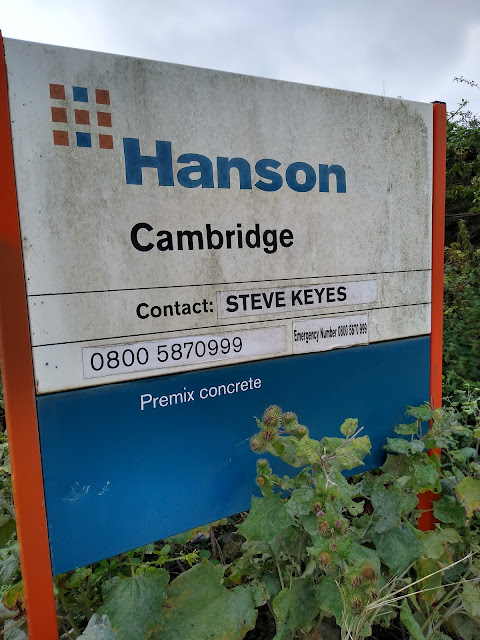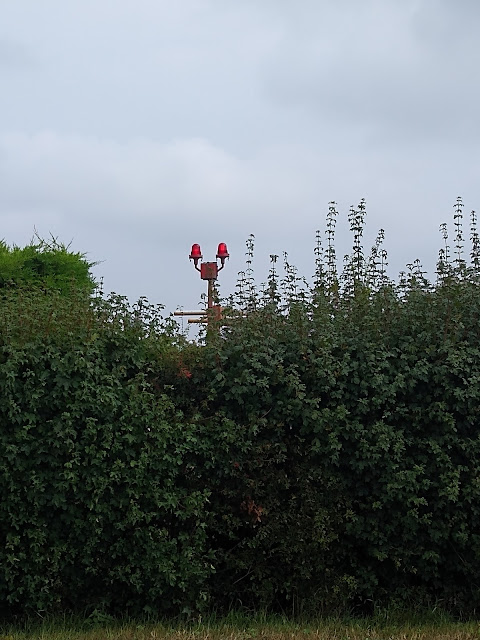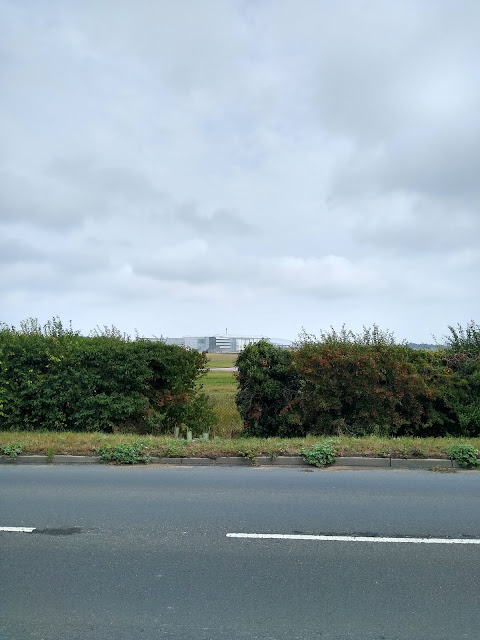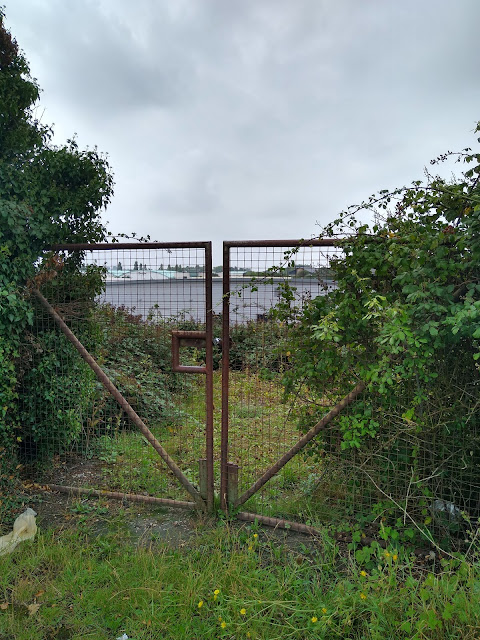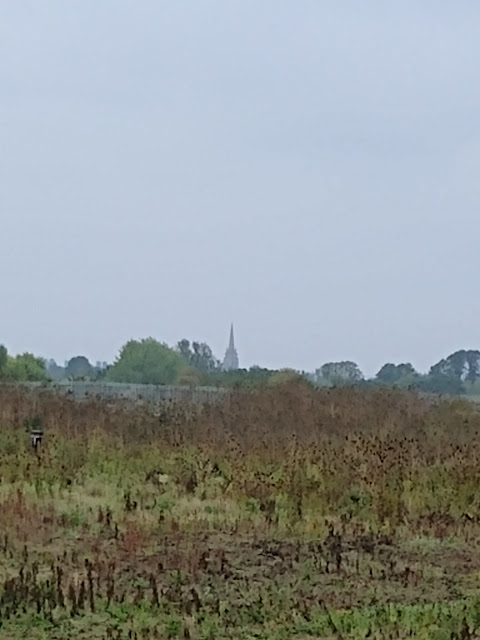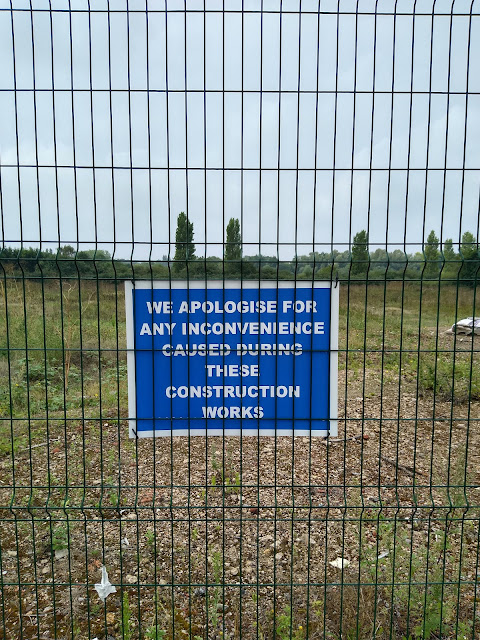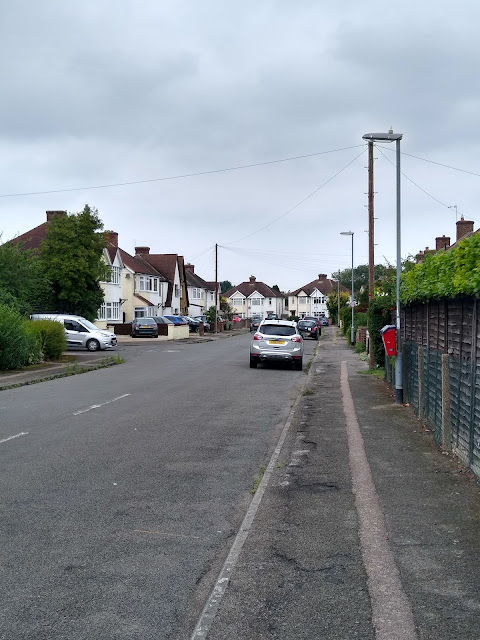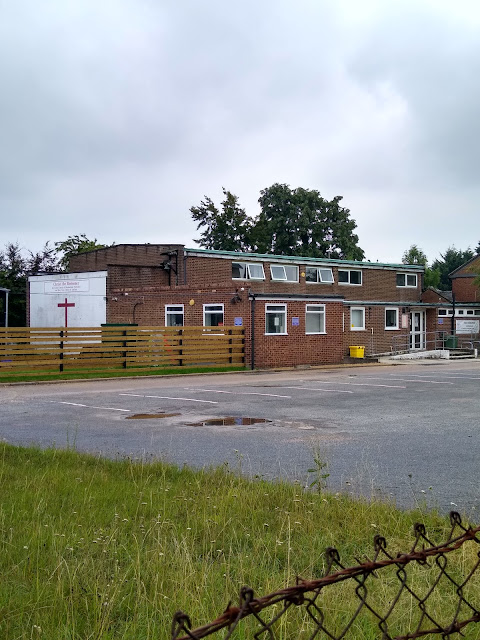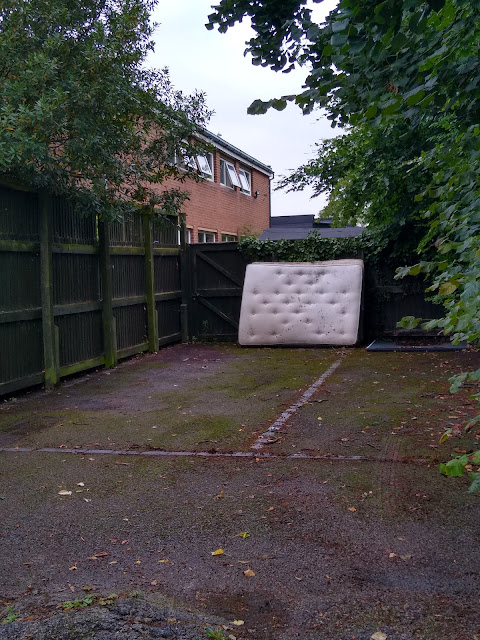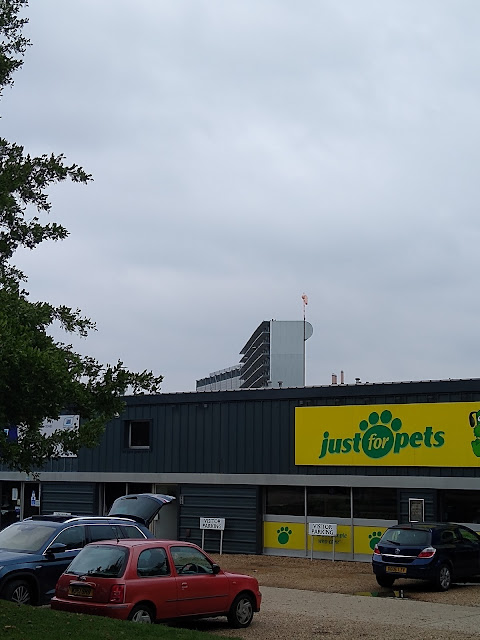Cambridge Airport is a place on the edge. Its airfield straddles the Eastern city administrative boundary that snakes across it from Newmarket Road to Cherry Hinton. But the airport's physical border with the city is with East Barnwell, the mainly residential area at Cambridge's Eastern Edge. The whole airport site occupies the majority of the land earmarked for development as part of the Cambridge East Area Action Plan. 'Cambridge East', as the area has imaginatively been branded, is a significant development planned on the edge of the City. Much will be housing but it has also been muted as an alternative 'focal point' to the existing City Centre. As such, the airport and much of what surrounds it, has become formally temporary.
The airport and its periphery is a liminal zone awaiting a transition to a future post Covid landscape. Once this process is eventually over, it will join other areas where developments have already been built, are in progress or planned at the edge of the city. A similar development is planned at the Northern edge of the City which is to be located in the area adjacent to Cambridge North Station. Currently it is a mixture of waste ground, business park and industrial land. It's major feature is the Cambridge Sewage Treatment Works, perhaps making it the untimate brown field site. The new location of the sewage farm is in the process of being decided between three shortlisted places. One of these, coincidently, is not far North of the Airfield, at a site around 'Honey Hill near Fen Ditton. The three potential sites, like the Airfield and it's periphery, are places in a state of suspended animation. Once a decsion is made, the unlucky 'winner' will remain a temporary zone in the run up to and during development. Then once the new sewage farm is operational the site will have fully transformed into the ultimate liminal place.
The time felt right to make an anti-clockwise navigation of the airport periphery, in the early phase of the 'pending' period it had entered along with much of the wider Cambridge edge.
I started at the boundary of Romsey and Cherry Hinton, where the railway crosses the bridge over Coldhams Lane, at the confluence with Coldhams Brook. The mysterious but ubiquitous Nigel and Tape were there, marking the transition into the peripheral zone beyond the bridge.
Beyond the bridge, the former landfill that makes up part of 'The Land South of Coldhams Lane' was enclosed by a spiked metal fence and 'private property keep out' signs. Like the airfield opposite, this land is also due for development, and presumably will form another part of Cambridge East. But for now it is a deslolate grassy expanse, peppered with methane release pipes. It felt eerily peaceful.
Adjacent, in a small corner between the landfill wasteland and the bridge, Hanson's pre-mix concrete is a remnant of the long gone Norman cement works that once dominated this area. This was the only sign of human activity in the immediate vicinity, although it was deserted today. Hansons, a leading supplier of heavy building materials to the construction industry, is part of the Heidelberg Cement Group. The town of Heidelberg is, coincidentally, twinned with Cambridge
Across the road, north of Coldhams Lane, the airfield was obcsured by hedge running most of the way along its Southern perimeter. Occasionally unsual lights and other bits of airfield infrasructure revealed themselves through gaps, hinting at a Whovian landscape beyond and sometimes resmbling unearthly and absurd beings. There was no sound from the other side of the hedge and no planes passed overhead as I traversed Coldhams Lane. The airport is, as far as I'm aware, still operational and Marshalls, the owner, still very much in business. The silence today was probably more Covid related than a sign of a reduction in activity reducing due to closure. Marshalls announced last year that it will be relocating and the land will be available for development from 2030. So this interim period is going to be a long one but, already, the Covid imposed silence presented a glimpse of things to come.
A gap in the hedge further along revealed a glimpse of the vast airfield and buildings beyond. Over at the North Eastern edge beyond the runway, Marshalls' headquarters sits among large aircraft hangers and bits of strange airport paraphenalia. In the scheme of airports, it is low key, and in comparison to say, Stansted or Luton, is a backwater. There are (or at least were) a few commercial fights to places like the Netherlands and Jersey and I was told that AstraZeneca chartered a plane that flew between Marshalls and Stockholm everyday to transport its workers between sites. Occasionally, large Hercules military aircraft can be seen flying low on their approach to land and jet engines of larger sounding planes could be heard at night, either being tested or getting ready to fly. But in my mind, Marshalls Airfield is mostly associated with smaller planes either used for local leasiure flights, flying lessons or pulling gliders into the air. 'Tiger Moth' by-planes and the occasional helicopter or hot air balloon were always a common site across Cherry Hinton when I was small. I pondered the lack of them recently and put it down to Covid, but I couldn't recall seeing or hearing very many for some time before the pandemic. Passing a gap in the hedge, at around about the same spot where people used to gather sometimes to watch aircraft come in to land, I tried to imagine the future view people would have instead. A vast sea of buildings, probably similar to the now pretty much complete Great Kneighton estate, with its bizarre mix of ultra-modern utopianism and 70s council estate aestetic.
My gaze was drawn back to the south side of the road. Here, a rusty gate blocking a gap in the hedge revealed part of the landfill and a giant warehouse on the Coldhams Lane Trading estate. Probably Bookers or Ridgeons. I had viewed the trading estate previously, from a strange grassy knoll that was part of the landfill but the other side of its deslotate expanse to where I had stood. I'd accessed this previously unknown space via a small chalky path off the Tins, during an early morning lockdown walk a couple of months back. The grassy knoll lay hidden just beyond the bushes and raised up above the grey warehouses, the metal fence running along one side and blocking off the main expanse of the landfill wasteland. Emerging into the space and seeing the vista of the warehouses below for the first time, I recalled bad science fiction or post-apocaptic 1980s Italian straight-to-VHS films, where eventually the utopia being searched for reveals itself as a sinister but slighltly underwhelming retail warehouse environment accompanied by bad synth music. The spot was oddly peaceful early in the morning, although there were signs of life (disgarded crisp packets, spent nitrous oxide capsules, dogshit, a dumped bike) that indicated it might not always offer solitude and respite from the Covid age at other times of day. I resolved to go back there soon on an early morning walk, when the atmosphere would be best.
I past beyond another gate, this time over the road at the airport perimeter. The first of many perimeter gates, festooned with various warning signs.
Heading toward to South Eastern corner of the airfield, one of the first developments that will eventually make up Cambridge East loomed into view, beyond the new liminal apparatus of a mobile phone mast and accompanying green box. A yellow development sign spotted soon after, across the road from a glassy car showroom, suggested this place is known as Eastfields. I'm pretty sure the land it sits on was previously a corner of the airfield. Immediately behind Eastfields is Hatherdene Close, a road of older white flat roofed houses. These always used to seem on the very edge of Cherry Hinton, slightly cut off and almost not quite real, located right on the edge of the airfiled.

Adjacent to these houses used to be
The Rosemary Branch pub and it's car park, located on the corner of Rosemary Lane. Together, the pub, its car park and the flat roofed houses occupied what seemed like their own marginal zone, a different jurisdiction where 'Sunday Lunch and Stripper' was perpetually advertised on a blackboard standing in the terminally near-deserted, windswept and pot-holed pub car park. The white houses behind were, at that point, fading to grey and seemed half real. The pub was demolished a few years ago and replaced with another residential development, similar to Eastfields. The older white flat roofed houses are now sandwiched in between the two larger beige neighbours and somehow seem a lot less remote feeling and whiter than they used to. The zone had been an anomaly previously. It still is, though for different reasons, but faces becoming swallowed by Cambridge East in years to come.
I passed through Eastfields and soon found myself in Hatherdine Close itself, among the old flat roofed houses. I realised it was a road I'd never walked down before. There is always something special about entering a space never previosuly visited or known about in a town you have lived in most of your life. By everyday criteria the place was unremarkable, but finding myself there was like emerging into a place that both familiar yet unfamilar, like somewhere remembered from a dream or old television programme. I had always noticed the row of slightly rough-around-the edges flat roofed houses when passing in my Dad's car when I was young, and wondering about them. At the end of the Close, the residents garages and pot-holed car park provided a crumbly and reasurring contrast to the newer surrounding developments. At that moment, the place did feel remarkable, the large pothole in the car park in front of me conjuing up on its own a higher concentration of comforting organic residential atmopsphere than Eastfileds was likely to produce over the next forty years, assuming the buildings last that long.

Between the rooves of the houses on Rosemary Lane, the 'Storage King' self storage facility loomed into view. Its dark blue crown hovered above the garages. The facility is located on the edge of a ribbon of business park running along Coldhams Lane, which at one time featured a couple of abattoirs. I remembered visiting one of them with a boy I went to junior school with, to see his grandad who worked there. Around the same time, I remember a teacher making the class watch a programme about about the cruelty involved in such establishments, hinting that we should become vegetarian. During 'any questions' at the end, she was horrified to learn that my friend was allowed to ride around on the backs of pigs when visiting his grandad at work. But now they are long gone, the memory buried beneath whatever people pay to keep inside 'Storage King'.
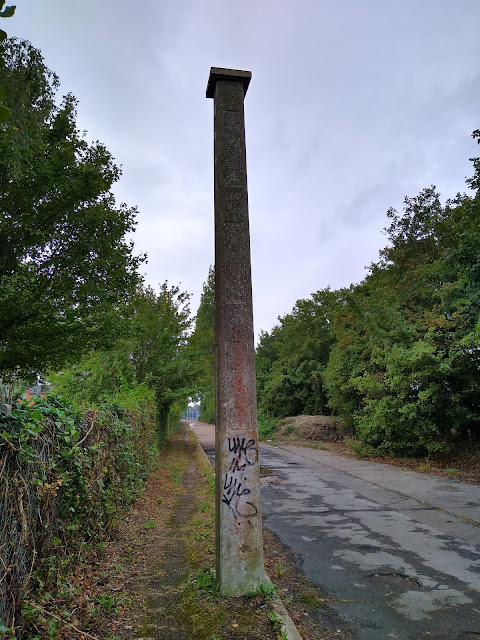
I deviated from my path, pulled back across Coldhams Lane to the 'Land South..' where a mysterious obelisk-like concrete post marked the begining of a track alongside the landfill and towards the Tins. To the left, shielded by a row of vegetation, is another fairly recent residential development. One that probably pre-dates the idea of Cambridge East, but will eventually be blurred into it. But I was more drawn to the track, the detritus dumped in its vegetative borders and the glimpses across the 'Land South of Coldhams Lane'.
A report on the Blue Circle Site (as the area was once known) from 1999
says of landfill gas 'all three former landfills are known to be
actively gassing and will be for many years'. While no significant risk
was thought to be posed by this, and no indication given as to what
'many years' would consitute in the context of lasndfill gas, I noted
the short posts dotted at various points in the ground and imagined they were still allowing gas to escape twenty years on, like static methane ambassadors.
Among the detritus in the hedge was a discarded blue board. The sequence of numbers it displayed in a triangular grid, prefixed by 'Off' , could have been a script for a numbers station. I imagined a covert Blue Circle shortwave broadcast from forty years ago, originating from a flat roofed white house, flickering in the halflight at the edge of the airfield, unseen by passers by. The leaves scattered on the board gave the impression of the beginnings of Autumn. But the day was hot, humid and felt like a storm could break and there had been little sign of summer giving way to the cooler season. Maybe this vegetative border, with its mysterious disgarded numbers board, was in a climbatic zone of its own at the edge of the seasons, out of time with its surroundings and the world at large.
In the distance, across the wateland, I could make out the shadow of what I thought was the Catholic Church, some miles away near the City Centre. At least thats what I told myself it was. As I stared in its direction, it started to resemble more a sinister giant conical headed figure, looming up and emerging from the distance toward the zone. Its malevolence was almost tangible. I managed to avert my gaze and carried on down the track, somewhat disorientanted by this unexpected and bizarre apparition.
At the end of the track, across the Tins path, beyond yet another fence is another area of land pending development in what was part of the old Blue Circle site and which has been left 'dormant' for several years. The sign indicated that works had already begun, but other than the sign nothing was noticable. There was certainly no inconvenience caused while I was there
Back across Coldhams Lane, I headed down Rosemary Lane, which curves around into 'Church End'. This is the name of a road but was also the name given to the Northern half of what is now Cherry Hinton, when it was a separate area. That was a long time ago, and now Cherry Hinton is in the final stages of being properly subsumed into Cambridge, just as Church End was subsumed into it. Among the newer buildings in Church End are a handful of old cottages. The one below is 'The Old Rosemary Branch', a former pub/inn, presumably a precursor to its later namesake. It now functions as an Air BnB but no 21st Centrury digital age connotations were visble from the outside. For a short moment I had left the Coldhams Lane/Airport edgelands to pass through a brief zone that might have met with the approval of the National Trust.
Then I looked the other way, and saw the vista of the back view of the business park environment that stretched from Rosemary Lane up to the 1950s housing of Queens Meadow off Coldhams Lane. The carpark that stretched out in front of me behind a bramble-infused wire fence appeared dormant and in the process of being re-colonised by the vegetation that was springing up in sporadically through the cracks in the asphalt.
Past this was a large 1950s looking building accomodating a car sales business, a suitably liminal business to occupy the flat roofed white building that seemed to go on for ages when walking past. Beyond this was a newer residential development, opposite the 1960s semis that the Old Rosemary Branch had given way to on the other side of the street. Neath Farm Court has taken over part of Neath Farm Business Park. I later read that one of the abattoirs used to have part of its operation located at around the same spot. Presumably before that the land had been part of the same area of farmland in which Marshalls sited the Airport back in the late 1930s,but I could find no reference to Neath Farm. The google search instead produced hits for estate agents selling houses in Neath Court, and a couple of Yell pages for companies located on the business park. The layers of history are always rendered much more effectively hidden from casual on-line searches if the subject is anyone or anything sharing a name with a residential development, street or other property location..
I turned into March Lane, and towards the point where it terminates and gives way to a footpath that follows the perimerter of the airfield's Eastern Edge. Just before this, I was distracted by an another apparent path through a thicket of trees at the bottom of Teversham Drift, next to a fenced off electricity substation. This path, such as it was, quickly terminated at the edge of a field of agricultural land which is part of the area identified for development as 'The Land North of Coldhams Lane'. This sector of land is just to the East of the airport and presumably will eventually become part of 'Cambridge East'. The field, though lacking the liminal strangeness of the ex-landfill sites in the neigbouring 'Land South of Coldhams Lane', was in a similar state of stasis, a temporary calm before the storm of pending development.
Eastern Edge
Not far along the footpath beyond the end of March Lane, I encounted more of the same spiked metal fencing that was being used to enclose the old landill sites. This time it enclosed small parcel of grassy land that stretched from Eastfields, enclosed by the footpath to the North and East and the Airfield to the West. This piece of 'pending' land was a perfect square, untouched for sometime judging by the undisturbed grass that had been allowed to grow wild. The area felt like it was waiting, but not in too much of a hurry for whatever it was waiting for to arrive. For now it remained an unassuming and pleasant piece of 'unofficial countryside', although one to which entry was barred.
The footpath followed a small watercourse at this point, presumably a drainage ditch, hugging the bottom of a farmers field. In front of me loomed a typically aerodrome shaped corrigated iron 'building', brown and rusted and partially colonised by vegetation at each end. The nissen hut like structure reminded me of the British Legion Hall in Cherry Hinton, now long lost to development.. The airport one though, was presumably a place for storing old bits of airfield paraphenalia or small aircraft, rather than being a venue for jumble sales, nanna tea and cake and Friday night discos.
The structure marked the point where the path turned right, to hug the Eastern perimter of the airfield. Here, a small bare branched tree, thickly colonised by some sort of ivy, stood like a stunted arboreal sentry, guarding the footbridge that passed over the small watercourse. This confluence was also marked by a number of other features on the airfiled side. A small yellow notice attached to the fence warned of CCTV operation. Just beyond this was a second structure, this time flat roofed, more recent and reminiscent of a prison outbuilding or the place that used to house the Fisons Social Club serving the old agri-chemical factory in Hauxton. In my memory, that was also in the middle of a field surrounded by a fence topped off with barbed wire and festooned with warning notices.
The perimeter fence featured a variety of sporadically placed warning notices as I contunued along the footpath. The penalty for unauthorised persons breaching the boundary was advertised as up to £1,000. At one point, the edge of the airfield, the boundary could be observed as a stretch of bare earth.
It aeparated the the grass of the airfield from the hedge that served as a barrier to the outside world. The bare earth 'path' aligned with a tall pylon like receiver of some kind in the distance, the most outlying piece of airport paraphenalia. A silent observer of places at and beyond the edge
At the point where the airport edge turned out along the northern edge of the farmers field and towards the main road of 'Airport Way', a lichen infested concrete fence post seemed to signify the long established but now temporary nature of the peripheral of the Eastern Edge. I realised at this point I hadn't ecountered any other people along this path. Despite the proximity of the outlands of Cherry Hinton and the village of Teversham, these places felt remote from the site of the lichen post.
Forced out onto Airport Way, the remainder of the Eastern Edge was a straight line of hedge, 'rewilded' grass verge, shared footpath and 50 mile per hour road. The yarrow and knapweed that had been allowed to grow in the verge was a welcome respite from the relative uniformity of this stretch. The hedge was too high to see anything much of the airfield, the only people I passed were a couple of serious looking runners and a similarly ernest cyclist and the road was the usual sporadic procession of bland 21st century almost uniform looking motor vehicles. This wasn't a region many came to for leisurely purposes, only for maximum travel efficiency when going somewhere else and with a straight face. Superficially a barren non-place, the yarrow and knapweed were wasted on these people, but I for one was pleased by their subtly disruptive presence.
Approaching the end of Airport Way, where it would shortly intersect with Newmarket Road and the Northern Edge, under a speed camera warning there was a yellow signifification that development was already underway nearby. Marleigh 'urban village' is a colaboration between Marshall and the Hill housebuilding company. The development was originally known as 'Wing'. I'm not sure what promted the name change. Marleigh means 'Marshy Meadow', presumably a reference to the increasingly Fen environment to be found to the North of the Airport beyond where Marleigh is situated.
Northern Edge
Turining West at the roundabout, I found myself on the the Newmarket Road heading along the Northern Edge of the airport in the direction of town. I soon encountered another gate. This one, Gate 3, featured a warning that anyone entering the aerodrome without permission faced the prospect of a fine not exceeding £2000. It was evidently cheaper to enter via the Eastern Edge where an earlier gate had featured exactly the same sign but with only a maximum penalty of £1000.
Across the road in between a gated off entrance to the Marleigh construction site and the Park and Ride was a half visible outbuilding or brick hut of some sort. It was sited next to a battered bit of beige concrete floor. I was tempted to cross the road to take a look but the traffic made it awkward. A site better left, maybe for a future walk taking in some of the environs the other side of Newmarket Road and one of the proposed sites of the new sewage works around an area called 'Honey Hill'.
I carried on along the perimeter fence, passing Gate 2. Still a maximum of £2,000 for trespass. Beyond this gate a rough tarmac track led out into the wider expanses of the airfield. It occurred to me that I still had seen no sign of life within the aerodrome from either man nor machine. There was little more life on my side of the perimeter other than than the moderate traffic flow of Newmarket Road and one family I encounted out for a walk. It seemed a strange place for young parents to bring a child, but I suppose it was at least easy to social distance, and maybe they were hoping to plane spot.
Peeping out over the bushes minutes later, when the family had faded into distant memory, I noticed another odd piece of airport paraphenalia. This flying saucer on a post topped of with an antenna resembled something from the future as imagined in the 1950s. Its low budge sci-fi presence was nontheless somewhat eerie.
I glanced across the road and could see a large crane looming above the BP garage. There will, apparently, be shops and a market square in Marleigh. But these sorts of features are usually the last aspects to emerge when they build these sorts of developments, if they appear at all. So the BP garage will probably be, at least for a provisional period, the main community resource.
The next gate bore a warning to vehicles fitted with CB transmitter installations. They were forbidden to be used. I wondered how widely CB (Citizens Band Radio) was used by anyone in the contemporary world or if this sign was a throwback to the early 1980s, when CBs were popular for a few years. It is hard to remember what the appeal was, but I suppose people didn't have Facebook then and had to waste their evenings doing something. CB was populised by American TV and Films with a particularly Southern bent like Convoy and The Dukes of Hazard. But the banter on the CB (at least in Cherry Hinton) was normally pretty low key to the point of inanity. But unlike social media a lot less infested with paranoia and pointless and hostile 'debate'. Maybe this was because Brexit, Covid-19 and QAnon had yet to be invented. Or maybe it was because you could only speak to people within a three mile radius and there was a significant chance you might encounter them in real life. Another appeal of CB radio was probably that, at least initially, it was illegal in the UK. The wavelength used by the American imported radios was already reserved for model aircraft flyers. These days, it seems CB use is mostly confined to truckers, farmers and cabbies, as well as being fitted as standard on some Harley Davidson motorbikes. But is still apparently prone to interfering with flying machines if the sign was anything to go by.
The land beyond the gate appeared particulaly Whovian. It was the sort of environment The Brigadier might be found with a supporting band of soldiers talking to John Pertwee about Sea Devils. The airport, not long after its establishment in 1938, had been used to train reserve Spitfire pilots in the second world war. Repairs and modifications to military aircraft were also carried out. The workforce included women who flew Spitfires to deliver them across the word. There have been multiple accounts of spectral figures in RAF uniforms on the site as well as the sound of footsteps in apparentlyempty buildings. David Curry's book The Men that That Never Clocked Off-Ghost Stories From Cambridge Airport (2004) documents these tales but I haven't been able to locate a copy. It was easy to imagine wartime figures occupying the area behind the gate, which looked like a place frozen in another time. Whether the presence of the spectres will persist to haunt future residents when the Airport is replaced by Cambridge East remains to be seen. Will the ghosts, along with the airport, be buried and forgotten under the new layer, or will they seep through the cracks and snags to haunt a new generation?
Back into the present, across the road, the Marleigh 'spirograph' caught my attention. I'm not sure if this is a temporary apparition, or an early example of the sort of public art that might manifest itself around the new development. Whatever it's meaning, it was at least something to divert the eye from the uninteresting flat roofed pair of buildings that stood just behind it. In front of it new sets of traffic lights stood hooded and dormant, as if waiting for some sort of ceremonial opening in which they would be unvield by a local dignitary.
Back on the perimeter, a new series of gates began with Gate F. Just beyond was a stumpy post resembling a milestone. I might have crossed the boundary back into Cambridge City by this point, but I never noticed the 'Welcome To Cambridge' sign. The milestone (if thats what it was) was more ambiguous as to whether it represented anything as jovial as a welcome. The lichen infested feature was from an indeterminant past age, while the disgarded disposable coffee cup next to it represented an early example of the culture that would inevitably manifest itself in the area, as it has elsewhere. One based around overpriced and often mediocre coffee. In this juxtoposition, the 'milestone' seemed forlorn knowing its days were numbered, while the coffee cup was mocking.
I imagined a homogeneity of residential development, similar to that in other recent or pending developments. The coming of these places is always heralded by uniform yellow signs pointing the way for contruction traffic. The names of the developments are the only noticible difference in the signs, the marketing and to a large extent, the places themselves. All will probably feature the odd street food van at weekends and ubiquitous coffee outlets at the expense of shops selling anything useful. Anything else will be imported from outside via a pelthora of vans and a variety of electric and hybrid mopeds. Maybe it was the overarching gloom brought by the preceding months of pandemic and and restictions coupled with the slowly accumulated atmospheric anxiety it had brought about that was making me feel less than optimistic about these future developments. But as I stood and observed the milestone and coffee cup, and the 'pending' land behind, at that point the thought of what lie ahead for both the development and the world in general seemed beakly dystopian'. A result of what the 'broken' milestone and the coffee cup together seemed to represent.

I carried on to Gate E, where the atmopshere altered. I had reached the main nexus of buildings around the head office and left behind the expanse of the airfield and its strange parephenalia. The first building was a modern affiair with an overabundance of black glass. But most were from an earlier age. The main buidling is the impressive modernist building by Harold Tomlinson that dates from 1937. It's grade II listed, but whether that will save it from demolition, or if a mysterious but convienient fire might break out just before the planning application needs to go in, remains to be seen. Hopefully the facade will at least stay put, even if what sits behind it has to be luxury flats or extortionate serviced accommodation.
At the end of the flat roofed ship-like headquarters was Gate D, just beyond which was a similar but slightly less grand building called 'Airport House'. Beyond and around it, a cluster of more utilitarian looking structures made up the rest of the Marshalls/Newmarket Road interface along this stretch.
Attached to Airport House, was a flat roofed brown structure with a blue door but no windows.It was separate (at least it appeared to be) from a building behind but I couldn't be sure. Both brought back the Whovian atmosphere momentarily that had been dispersed by the modernist buildings.
Beyond the row of Marshall buildings, it felt like I'd left the Airport behind. I still wanted to follow the remainder of the perimeter but it was lost for now somewhere behind a row of houses and could not be accessed. These were 1930s vintage pebble dash vintage dwellings. There was something slightly other about them beyond the unusual dark beige concrete door frames that each carried the name of a flower. The buildings themselves displayed very little in the way of floral qualities, but they were impressive in their solidity while at the same time emanating a sort of spectralness.
These gave way to the turning into Meadowlands Road, which headed off Newmarket Road towards the edge of the Airport. This was another road I had never been down before. Its location was on the opposite side of the Airfield to that of Hatherdene Close. An imaginary diagnoal line across the airfiled connected the two roads, and bifurcated the runway which was equidistant from each. I had forgottin the road existed and had orginally planned to carry on up Newmarket Road. But I diverted. The gravitational pull of another previously unexplored road, one with a spurious geometric connection to the earlier never before visited street I'd walked down, was too great to resist.
For some reason I had always assumed Meadowlands Road was a cul-de-sac, ending at the airport edge. But it turned right and another stretch of houses began, before the road turned left up ahead. This felt like a revalation. By this stage, he action of walking the distance (not that far, probably 4 or five miles)and only 'interacting' with objects and places, not people, had put me into the sort of slightly trance-like and off-kilter state that one often gets on this sort of walk. That might have accounted for my slightly heighted perception of the importance of this stretch. The 1930s houses at the beginning of the unexpected second road had a similar feel to those I'd passed just before turning off from Newmarket Road, but with the added forboding atmosphere brought about by a hulking airport hanger looming in the background, visible between gaps between houses.
It became more visible when the houses gave way to a gate on the airport perimeter. The partial holloway of trees did little to dispel the liminality of this border. The barbed wire, the sign warning unauthorised persons of the consequences of trespass and looming windowless grey hanger behind made for a slightly menacing sight, made more so by the suddden unexpected gap that had appeared between houses revealed the scene.
I reached the end of the stretch where the road turned left. At this corner were two road signs. 'The Homing' was the strecth I had just walked along, while left was 'The Westernings'. It continued to follow the airport perimeter and was lined each side by more of the post war houses that the initial 1930s ones had given way to on the Homing. I couldn't see what was at the end of The Westernings and was about to carry on but then noticed a passage between the tow signs heading between the houses back in the direction of Newmarket Road. I hesitated, but the passage won, depsite the chance to carry on following the airport's edge. What was at the end of The Westernings would remain a mystery for another day.
I wondered about the name 'The Homing' which seemed at the same time a strange but ultimately sensible name for a road. It might have referred to homing pigeons, or due to its proximity to a former military airfield homing missles. Or maybe just a reference to the act of coming back to a haven after a terribe day at work. I imagined a past scene.featuring a long line of workers interspersed with the occasional bowler hatted manager heading home after a day at Marshalls, grateful for being able to walk a short distance to a reasonably comfy house for their tea. Years later, at least until the advent of Covid, most commuting in this area consisted of people having to come into town from outpost villages with inadequate public transport and getting stuck on Newmarket Road in a traffice jam for ages.
Leaving these thoughts behind, I headed up the passage, with its slightly disconcerting graffitti free and newish looking corrigated iron fences.
Near the other end of the passage the fences were a proper corrigated iron brown colour. Being in the passage here had a similar feel to the post-war estate my grandparents lived on when I was growing up. The feel of the 1970s experienced in a 1950s environment.
I emerged back onto Newmarket Road, at the beinning of a series of three municipal buildings. All were one level flat roofed structures, with weathered asphalt car parks. The first of these, The Cambridge Spiritualist Church, was the newest of the three, maybe dating from the late 1980s or 1990s. The Spiritualist Church relocated here from a building in Thompsons Lane in the City Centre in 2008, taking over the building from the Methodist Church. I suppose Spiritualism is an offshoot of religion that is regarded as fringe, both by the Church of England and the public at large. The newer location on the egde of town, in one of Cambridge's less salubrious areas, seemed symptomatic of the this status. Cambridge City Centre continues to become somewhere far less tolerant of anything fringe that does not fit in with its ever increasing expensiveness and bland homogeneity. Will places like this be pushed further out post 2030 to a more distance periphery or will they simlpy disappear? Dwelling on this, I planned to try and do the same walk in 10 years time to survey what, if any, remnants of this area might still be found.
The second 'fringe' building was East Barnewll Community Centre. These types of places, invaluble assets for the community they serve, are ever rarer. They are easy targets for property speculators and developers. I couldn't imagine this one surviving the coming of Cambridge East.
The third flat roofed municipal structure was the Church of Christ the Redeemer.If it wasn't for the large red crucifix adorning the only white painted wall, on the otherwise 60's brown building, it could have been taken for an office or a workshop on a fading trading estate. But the presence of the white wall and the cross produced a feeling that the building was of two halves. The half with the cross resembled the sort of backwater rural church hall that might be found in the most remote parts of 'Goob Country' East Anglia. Meanwhile the other half resembled a small block of shetered accomodation from the fringes of a small town suburb. The fairly expansive and aging tarmac car park, with its pot holes and puddles, was empty. This was Sunday, but a Sunday in the Covid-era. The church's website confirmed they are now in 'interregnum' which was presumably a reference to the pandemic and the explanation for the empty car park and dearth of worshippers. Or maybe it was a reference to some pause in activity before a revelationary or cataclysmic religious event. The location of the church on the airport periphery meant, like its neighbours, it was now part of a ten year interregnum pending the arrival of Cambridge East.
Along the edge of the car park was a footpath, following the rusty and dilapidated fence and with a central barrier to presumably seperate cyclists and walkers. The path curved left and headed towards a 1960s housing estate, another place I realised I'd never been. I had never before noticed this path. I was once again pulled from the route along Newmarket Road, down the path which felt like a relic from a golden age of municipal housing which I took for granted as a child but would probably never be seen again for a long time. The decreptitude of the path was in a way comforting, but a reminder of something lost.
Western Edge
The path marked the transition from the Northern to Western Edge of the airport periphery. It deposited me behind the church and at the edge of the 1960s Council Estate which is built around Peverel Road. A matress had been deposited in the weird space at the back of the church. This seemed to be a couple of car parking spaces covered in a thin film of moss in front of a gate that accessed the backway of the building. Why the church needed even more car parking was unclear, but maybe it was a back entrance for important visitors. It didn't look anymore 'exclusive' though than its the larger counterpart out the front, not least because of the presence of the off white matress leaning against the fence.
I emerged into Peveral Road and soon found myself at an open greenspace, which was at the centre of the estate. There were children playing on the field and parents chatting. I immediately spotted a community noticeboard situatied at the edge of the green. For some reason, I've been 'noticing' these sorts of noticeboards a lot since lockdown, I don't quite know why. Some have been functioning to alert people of covid-related services and self help groups, suddenly seeing a surge in demand for their services. Others have had nothing new to broadcast for some years. But regardless they seem to have re-emerged into , paradoxically in a digital age where most analogue 'services' have been disgarded. Maybe they are a totem of solidity, outsideness and reasurrance in a time when increasingly its more difficult to esacpe the digital world for any length of time in one form or another.
I didn't visit the noticeboard on the green due to the proximity of people. I kept a good social distance, for covid reasons. But also because I suddenly felt less invisible. I hadn't seen anyone other that the family on Newmarket Road and the presence of others, while not unwelcome, brought me out of my previous state which was one where I remained unobserved and merged with my surroundings.
I turned out of the estate back onto Newmarket Road. I wanted to fill in a bit more of the 'circuit' around the periphery of the Airport and it seemed important that I cover the whole of Barnwell Road. I also fancied a drink of water and some chocolate and wanted to visit the parade of shops where Barnwell road has its confluence with Newmarket Road.
I detoured down a driveway that headed around the back of Newmarket Road Library (which is in fact situated on Barnwell Road..but maybe it wasn't originally). Behind the library was a piece of pubic art featuring what appeared to be depictions of ancient weapons; a shield, sword, axe head and possibly a helmet. Maybe these are a reference to Pagan Peveral, an Anglo-Norman nobleman who was granted land belonging to Barnewll Priory in the 10th century. Peveral Road is clearly a reference to him and was probably farmland belonging to the Abbey at the time. That area, immediately around the Abbey, is no longer officially known as Barnwell but the name survives. It has become synonymous with the area East of Barnwell Junction, the railway line and Coldhams Brook. The area to the west of this boundary makes up the other half of Abbey Ward but doesn't really get referred to as a distnct area. East Barnwell on the other hand, has an identity of its own, even if this unofficial. It is one of the most deprived areas of Cambridge and maybe for some the name identfies a zone to be avoided, but for others it represents a cohesive community and one of the last yet-to-be-gentrified parts of Cambridge.
I passed the back of the library, where one of the window apertures appeared to be containing what appeared to be a giant brain.
Central to East Barnwell is the parade of 1960s shops adjecent to the Library. I had a rest on a bench to drink some water I'd bought from the Spar shop. Directly in front of me was a lampost identical to the ones on the estate I grew up in at Cherry Hinton. An artefact from the 1970s, it was a beacon of nostalgia. The parade of shops themselves also conjured vague feelings of childhood, too vague to count as memories, more a sort of 'stmosphere' specific to a half remembered time . There is a similar parade in Wulfstan Way, nearer to Cherry Hinton. But this one on Barnwell Road, I realised, would have probably been somewhere I was brought as a very small child when we lived on the nearby Whitehill Road estate, above a Co-op. Maybe thats why the parade of shops, and its twin in Wufstan Way, bring back these feelings.. I was two years old when we moved to Cherry Hinton.
I noted that the name Barnwell feature at the Barbers, which was an indication that the area and its people still identified as 'Barnwell'. Other than the road and community centre the name also is recognised at a Bapist Church on the post war estate around Dudley Road as well as the East Barnwell Health Centre in the adjacent 1980s estate, the newest bit of Barnwell and where my mum still lives. Next to Barnwell Barbers is a community organisation called 'Abbey People'. The shop front also says 'East Barnwell and Abbet CIO', reasserting East Barnwell as an area or community with a distinct identity, as opposed to the rest of the Abbey Ward to the West.
Just after the walk, I came across a link to 'The East Barnwell Masterplan' on the 'Abbey in Cambridge' Facebook Group. It took me to the page on the City Council's website headed 'Working towards a brighter future for East Barnwell' and subitled Est Barnwell Regeneration'. It explained that the frst stage of the 'East Barnwell Conversation' was complete, with over 1000 local people having had their say about want they wanted to see in the area. Local people included those from across the wider Cambridge area and the main themes emerging from the feedback were displayed diagramatically. They were what you'd expect: road and traffice improvments, more community facilities and greenspace, better facilities like cafes and pubs, housing, open space and concerns about polution and sustainable transport. As ever, its not easy to discern how much of this comes from local residents or various interest groups (or 'key stakeholders'), or how much of it is a genuine attempt to engage with the community to improve their lot as opposed to just a box ticking 'non-sultation' exercise.
Another Council document,
East Barnwell, Cambridge A Framework For Change seemed a bit more enlightening. The five main objectives include a 'regenerated local centre as a new heart for the community' , improved cycling routes, improved public transport and walking routes on Nemarket Road, and an improved and expanded 'leisure offer' to aid health and wellbeing, as well as 400 new homes of mixed tenure.On the face of it positive things, But reading between the lines, some of the language used to describe the present area indicate it is seen with a certain amount of derision mixed with a property developer opportunism.
'..threats from car parking and tall fencing/back garden fences creating hostile boundaries and areas of no passive surveillance. These spaces are not well connected and do not contribute to a comprehensive network of public open space across the Ward and study area'. The first sentence conjures images of a council estate dystopia that could only exist in the mind of the most paranoid of the middle class people. The second hints at the developer spotting an opportunity to 'upgrade' it and sell it to those same people for a premium. Maybe I'm being too sceptical, but East Barnewell is one of the few areas left in Cambridge that hasn't already been gentrified or in official parlance 'regernerated'. The 'masterplan' presumably will dovetail into the development of Cambridge East. The temporary zone around the Airport was a lot larger than I had realised during the walk.
After my respite considering the municipal 1970s atmosphere of my childhood and the identity of East Barnwell, I headed back into Peveral Road to explore the estate a bit more and to see if I could emerge from it further down Barnwell Road in the directon of Coldhams Lane. The underpass at the end of the road crosses Barnwell Road, and is perhaps Cambridges second best underpass. Cambridge is not a city blessed with them and, come to think of it, apart from the Elizabeth Way roundabout that features the best example, this is the only one I can think of. It contained the same atmosphere as the parade of shops. Vague childhood 'memories' that were probably a mixure of real life and half remembered outdoor scences from programmes like Grange Hill.

I passed along Peveral Road, heading south past a parade of post war council houses of the type my Nanna lived in. Eventually, I came across a gate which at first I thought must interface with the airport. But it was an allotment, part ot the Whitehill Allotment Society. 1960s estates like this often featured allotments so this should not have been a surpirse, but I couldn't work out the geography. Later, when checked google maps there was no mention of it. On the Ordnance Survey map a blank area with a footpath was clearly visibale as the allotmets, but not marked as such. It sat between the end of The Westernings and the Barnwell Business Park,which is to the south of Peveral Road.
I carried on and veered off between some houses, soon finding myself on a seemingly random triangle of grass that featured a strangely impressive Hawthorn bush that's lower half was engulfed in ivy. The space looked like it had been designed for low key community pagan ritual, but I suspected was rarely, if ever, used for any communal activity. It had the feel of somewhere never visited, apart from by the council lawnmower.
Another space that looked rarely visited was an enclave of garages. This provided an opportunity for flytipping and somebody had taken advantage to deposit the second disgarded mattress of the day. Was this offering from the same people who left one at the rear of Christ The Redeemer?
I couldn't make out if what lay beyond the fence was part of the airport or the business park, obsured as it was by trees that only revealed part of an asphalt car park and bits of industrial buildings.
I doubled back, there being no route through the garages. I soon found myself deposited back on Barnewll Road, further along from the underpass and just before the area around the Business Park on Barnwell Drive. I was tempted to divert but decided against it. I carried on to complete the circuit of the airfiled. The end was in sight and I was wearying.
A stretch of trees obscured the edge of the Airfield and the Business park. I would hesitate to call it woodland, but it was posssible to go into it and be hidden from the passing cars. I contemplated that but was distracted by a yellow development sign for 'Countryside Aura'. This is a development on Long Road, part of Great Kneighton and this sign appeared to be pointing in the exact opposite direction. Maybe the work of a prankster or someone sick of a constant stream of construction traffic passing their house and hoping to divert it on another route. If any builders ended up in Marleigh by mistake, would they even notice the difference?

As I pondered this, a man passed by riding a horse and trap taking his kids for a ride. People riding horse and traps had become slightly more common site during the earlier lockdown when traffic was at an all time low. Normally they are confined to Chesterton, in near proximity to the travellers site at the end of Fen Road, adjacent to the previously mention sewage treatment works. But during lockdown I had seen someone ride around Elizabeth Way Roundabout. I witnessed another rider heading down Trinity Street, towards Kings College, a place as far removed from the site on Fen Road as it was possible to get in Cambridge. Now the traffice had returned, as the rider who passed me was experiencing. Drivers showed little patience as they overtook him, not making any attempt to slow down, wait or give sufficient room hen they overtook. The rider hugged the kerb, but thiswas not enough for any acknowledgement or thanks from the drivers. Why they were in such a hurry on a Sunday afternoon was anyones guess. But a sign that some of the worst aspects of the old normal were returning. The horse and trap people were representaive of the brief period where it seemed that there might be an opportunity for positive change out of the Covid-dystopia. That feeling feels like a distant memory, lost about the time the drive through McDonalds reopened up at the end of the road. This prompted serious traffic jams along Newmarket Road and Barnwell Road as those desperate for a happy meal were prepared to sit in a quie for hours to get one.
I'd not heard of any queing for Pets at Home or any of the handful of other businesses here. These were either retail warehouse type outfits, motor dealers, a hand-car-wash and the Ex Servicemens Social Club just inside Barnwell Drive. Above Pets at Home a behemothic building that I could only describe as coming from a retro-futurist Eastern Europe reached into the sky. I hadn't noticed this before and had no idea what it was for. Presumably part of the Airport since a windsock on a pole stood next to it. The resembled a giant grandstand built for viewing an as yet to be invented sport.
Soon after this I reached the end of the circuit, at the railway brdge crossing Barnwell Road and marking the boundary of East Barnwell and the Abbey Ward with Romsey and the Sainsbury's Roundabout. The three slogans I could make out were clearly commentary on the current prediciment: 'Tomorrow forgotten..due to lack of interest', 'It's so funny how we don't talk anymore' and the less defeatest sounding 'this is what we've been waiting for, RAISE UP!' I couldn't be sure whether this was the work of those optimistically hoping for some sort new utopia to emerge from the current crises or that of Covid denier anti-vax types, who luckily in this country have very limited access to guns. The latter seem to be getting far more publicity than the former. I wondered if it was time to learn to ride a motorbike and acquire the sort of spiked leather gear suitable for a road-warrior type existence. One where petrol is inexplicably plentiful but water rare and the people are not very nice.
I drifted through the bridge. completing my circumnavigation of a zone that was entering a period of slow motion upheaval and change, within a period of global change and uncertainty. Maybe by 2030 the vision of Cambridge East will have been realised, transforming East Barnewll, the airfield and its periphery in line with the planner's 'vision'. But maybe things will be knocked off course by the pandemic and its 'new normal' aftermath.


